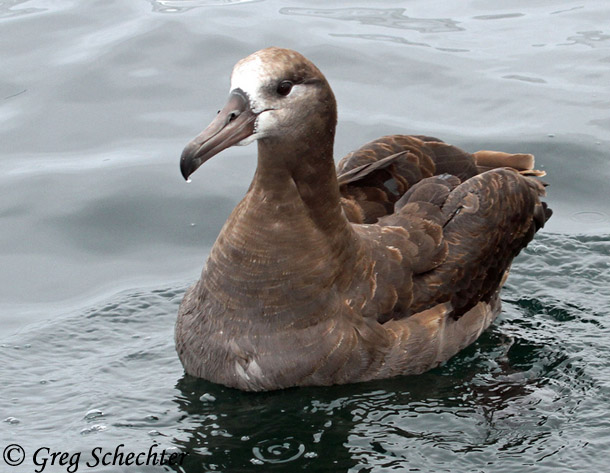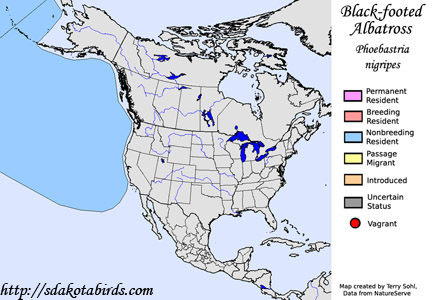| Length: 32 inches | Wingspan: 84 inches | Seasonality: Non-resident in South Dakota |
| ID Keys: Gray overall, with pale face, pinkish-gray bill | ||
 The
Black-footed Albatross is a bird of the North Pacific, breeding on the
Hawaiian Island chain and on islands off the coast of Japan, but with
non-breeding birds wandering widely across the Pacific. They are similar to
other northern Hemisphere Albatross species with regard to breeding habits.
They mate for life, with pairs performing noisy courtship dances to reaffirm
pair bonds upon returning to their breeding grounds. Unlike other
species that often feed at night, Black-footed Albatross have relatively
poor night vision and primarily feed during the day. This may be due
to their preferred food item, flying fish eggs, while other albatross
species often prefer squid species that are closer to the surface at night.
The
Black-footed Albatross is a bird of the North Pacific, breeding on the
Hawaiian Island chain and on islands off the coast of Japan, but with
non-breeding birds wandering widely across the Pacific. They are similar to
other northern Hemisphere Albatross species with regard to breeding habits.
They mate for life, with pairs performing noisy courtship dances to reaffirm
pair bonds upon returning to their breeding grounds. Unlike other
species that often feed at night, Black-footed Albatross have relatively
poor night vision and primarily feed during the day. This may be due
to their preferred food item, flying fish eggs, while other albatross
species often prefer squid species that are closer to the surface at night.
Habitat: Found on sandy beaches and other open habitats when breeding. In other seasons, they are found in the open ocean, most commonly where upwelling currents concentrate prey items, but typically far from shore.
Diet: Feeds on fish, squid, krill, flying fish eggs, and sometimes carrion.
Behavior: Feeds by swimming on the ocean's surface, dipping underwater or making short underwater dives to capture prey.
Nesting: The Black-footed Albatross mates for life. The nest of is a simple depression in the sand, placed on a high-spot on a beach. The female lays one egg, and both parents incubate it for the 2 month incubation period. Upon hatching, parents take turns watching the youngster, and going out to forage for food.
Interactive eBird Map: Click to access an interactive eBird map of Black-footed Albatross sightings
Song: Has variable squeaking or moaning calls, and also makes bill-snapping sounds on their breeding grounds.
Migration: Breeds on islands in the far northwestern part of the Hawaiian Island chain, select islands off the coast of Japan, and a few islands off the Mexican coast. Non-breeding birds can be found roaming across the North Pacific at any season, but adult birds in breeding condition do concentrate near breeding sites during most of the Northern Hemisphere winter and spring (their breeding season).
Similar Species: Within its normal range, unlikely to be confused with other Albatross species, each of which has significant white portions of their plumage.
Conservation Status: Populations steeply declined in the 1800s due to the collection of eggs and adult birds for food. After recovering somewhat in the first half of the 20th century, the species again began to decline, particularly when longline fisheries began to be heavily used in their feeding territories. Longline bycatch of the species has declined somewhat in recent years, but the IUCN lists the Black-footed Albatross as a "Vulnerable" species.
Further Information: 1) Audubon Guide - Black-footed Albatross
2) BirdWeb.org - Black-footed Albatross
3) Cornell's All About Birds - Black-footed Albatross
Photo Information: Photo taken by Greg Schechter - September 24, 2011 - Off the California coast - Photo licensed under Creative Commons Attribution 2.0 Generic License.
| Click below for a higher-resolution map |
 |
| South Dakota Status: Non-resident in South Dakota. Only one record in North America. |
Additional Black-footed Albatross Photos (coming soon!!)
